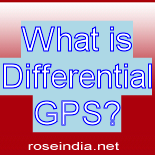What is Differential GPS?
Introduction
Differential GPS (DGPS) is a land-based technology that works to improve the accuracy of GPS navigation. Differential GPS improves the accuracy to within two meters of the actual position for moving objects and even better for stationary situations. Differential GPS takes GPS to a much higher level- it becomes a tool for positioning things on a precise scale.
How it Works
Differential GPS works through two receivers one of which is stationary and the other moving around making position measurements. Here is the underlying principle. GPS receivers calculate distances by using the time signals take to travel from satellites. This work needs signals from at least four satellites. Each of these signals has some errors due to different factors like disturbances in the atmosphere. These errors can have a cumulative effect in the final result the GPS gets. However the satellites are so far away in space, the distances we travel on earth are pretty insignificant in comparison. This way the signals two receivers within a distance of a few hundred kilometers receive have the same amount of errors, as they have traveled the same amount of distance in atmosphere. This is the principle put to use in DGPS. The stationary (reference) receiver is placed at a point that has been very accurately marked and surveyed. This station is considered to receive the same GPS signals with the same amount of error as the moving receiver. The stationary receiver then works backwards on the equation. This means that instead of using timing signals to work out its position, it uses its already measured position to calculate timing. It then compares how long the signals should take to travel with the actual time they took to reach the station. The difference in the two readings gives the error component which is common to it and the moving receiver. The stationary receiver repeats this process for all the visible satellites, encodes the information into a standard format and then relays the information to the moving receiver. The moving receiver is thus able to make appropriate corrections. Error Transmissions- the nitty-gritty DGPS receivers cannot transmit the corrections on their own, but use attached radio transmitters for the corrections. The moving receiver gets a complete list of errors, meaning errors with reference to each satellite, and applies whichever data is applicable to them. Limits Differential GPS can eliminate only those errors that are common to both the stationary and moving receivers. This does not include multi-path errors (these are errors that happen due to the signals reflecting off objects like mountains, tall buildings and dense foliage), as these are happening very close to the receiver. Further, DGPS cannot account for any internal errors within an individual receiver.



